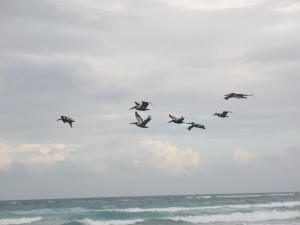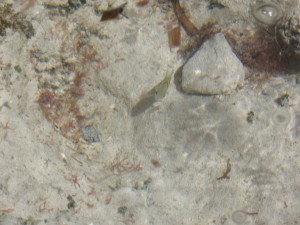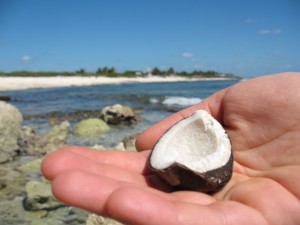We awoke to the call of loud-mouthed black birds that we would later learn are called grackles. They liked to perch on the roofs of the rooms in front of us. Sometimes they would venture onto the handrail of our balcony. We had a slightly set-back view of the beach from our window, which proved to be the right amount of seclusion. The location of our hotel is also a bit separated from the crowds. There is a small cluster of hotels and restaurants about 100 meters to the north where the road to downtown Tulum (“el pueblo“) meets the beach and another larger cluster in the main hotel zone 150 meters to the south. The shoreline in front of our hotel was also protected by two small rock formations. When the water was turbulent (which was the case for the majority of our stay), this was a favorite spot for pelicans to survey the water for fish that were being washed ashore.
On one of these days, about 7-8 pelicans would be in sight – some resting on the rocks, some standing with their wings outstretched, airing out their pits, and some circling above the water. When they spotted a potential snack, they would stick their feet out as rudders and tilt themselves straight down, plunging beak-first into the waves. Then they would sit atop the water and bob over one or two more waves. If they caught what they were looking for, they were looking for, they would tip their heads back to swallow. Then they would lift off again and repeat the process.
The pelicans were surprisingly unfazed by humans. They would let somewhat conspicuous tourists who were trying to take photos get within about three meters of them. If people tried to get closer than that, the pelicans would just take a couple of steps back. One worker was out on the shore every morning performing what Em fittingly described as a sissophean task of raking seaweed off of the sand and carting it off in a wheelbarrow. This fellow seemed to have a particular rapport with the pelicans. They would let him get within arm’s reach, and when he would raise his arm, the pelicans would raise their beaks sympathetically. Em once saw the pelicans mocking some tourists. One fellow looked sternly into the ocean for a while, and a pelican stood still beside him looking straight ahead.
One day, Em was walking along the beach, and she found a pelican airing out his pits on the shore. She stood beside him and did the same, trying to get my attention as I was riding down the road on a bicycle I had just rented. Unfortunately, I was preoccupied with navigating traffic, and I failed to notice. She ran up as I got back to the hotel and told me about it. I really wish I could have seen this. I asked her to go re-enact it with another pelican, but she declined.
Small tidepools formed in the rock formations. Often, these were slightly littered with beer containers and cigarette and food packaging. We picked up what we could. But in the tidepools were some striped yellow and black fish which ranged from 3 to 7 centimeters long. Also in the crevices were some crabs about 8 centimeters wide.
I went snorkeling in the cove on a somewhat choppy day, mainly to get accustomed to the equipment. Em pointed out that she didn’t think it was a good idea since there was no one else within eyesight swimming. She planned to read a book but ended up playing lifeguard and keeping watch. There was a good amount of coral inside the cove. It seemed to be healthy, given what little I know about coral. It was mainly white with some small bits of red. I learned that coral can become bleached if it is damaged, so I’m not sure if that was the case here. I made the mistake of standing on the coral at a couple of points when I was adjusting my mask because the stuff was spread in patches all over the sea floor. I didn’t realize that wasn’t a good idea until Em later said, “you didn’t touch any of the coral, did you?”. The coral was quite sturdy and didn’t seem to break at all, but I’m sure I didn’t help its situation. We made a point to donate to some cause that furthered coral preservation, which we later did in a way with our admission to the Sian Ka’an biosphere. Anyhow, while snorkeling in the choppy conditions, I couldn’t see anything aside from a haze of blue and brown – I couldn’t even see clumps of sea weed until they were right in front of my face. Breathing with my entire head underwater definitely took some getting used to, but this served as decent practice.
We saw a sign about making sure not to disturb turtle nests, and we saw some loosely formed piles of sand, which, naturally, we thought were turtle nests. Later, we realized that it wasn’t nesting season and the piles were left by the worker who swept up seaweed every day.



